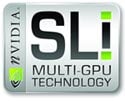Do-It-Yourself Quad-SLI: It's Official
Introduction to Quad-SLI

 For almost a year now, NVIDIA has been teasing enthusiasts with their Quad-SLI technology. It was back in January at the Consumer Electronics Show that we got our first glimpse of a Quad-SLI based system, the Dell XP 600 Renegade. That first Quad-SLI implementation consisted of four GeForce 7800 GTX GPUs, each coupled to 512MB of graphics memory, for a grand total of 2GB of frame buffer memory. Although it looked like four separate graphics cards were used to build up those early Quad-SLI systems, it was actually two. Each GeForce 7800 GX2 card as they became known consisted of a main 512MB GeForce 7800 GTX with a secondary daughter-card mounted to one side. The GPUs each got their own slim coolers, and the main- and daughter-cards communicated to each other through a proprietary link. Then two GeForce 7800 GX2 cards were installed into an appropriate nForce 4 SLIX16 based motherboard, and linked together via a pair of SLI connectors. NVIDIA also developed a proprietary switch for these early cards that allowed each 7800 GX2 card to interface with a single PCI Express X16 slot for full bandwidth operation.
For almost a year now, NVIDIA has been teasing enthusiasts with their Quad-SLI technology. It was back in January at the Consumer Electronics Show that we got our first glimpse of a Quad-SLI based system, the Dell XP 600 Renegade. That first Quad-SLI implementation consisted of four GeForce 7800 GTX GPUs, each coupled to 512MB of graphics memory, for a grand total of 2GB of frame buffer memory. Although it looked like four separate graphics cards were used to build up those early Quad-SLI systems, it was actually two. Each GeForce 7800 GX2 card as they became known consisted of a main 512MB GeForce 7800 GTX with a secondary daughter-card mounted to one side. The GPUs each got their own slim coolers, and the main- and daughter-cards communicated to each other through a proprietary link. Then two GeForce 7800 GX2 cards were installed into an appropriate nForce 4 SLIX16 based motherboard, and linked together via a pair of SLI connectors. NVIDIA also developed a proprietary switch for these early cards that allowed each 7800 GX2 card to interface with a single PCI Express X16 slot for full bandwidth operation.



NVIDIA's Booth at the 2006 Consumer Electronics Show
Those early GeForce 7800 GTX based Quad-SLI systems we saw at CES never fully materialized, however. Instead, NVIDIA updated those early GX2 cards with the re-vamped G71 GPU and created the GeForce 7900 GX2. The GeForce 7900 GX2 required less power than the early 7800 GTX-based cards, which allowed NVIDIA to clock them higher and eliminate a proposed external secondary power supply requirement. A smattering of 7900 GX2-based Quad-SLI systems were sold through a handful of strategic partners for a time, but they too never became widely available. And disappointingly NVIDIA never allowed their partners to release GeForce 7900 GX2 at retail.
Then, in June of this year NVIDIA unveiled the GeForce 7950 GX2. The 7950 GX2 was powered by essentially the same GPUs as the 7900 GX2, but the 7950 was based on a streamlined PCB that was much smaller than its predecessors. NVIDIA was able to do this by dedicating only half the number of PCI Express lanes to each GPU and redesigning the PCB and slim-coolers altogether. Another major difference was that NVIDIA launched the GeForce 7950 GX2 at retail. On the day of launch, enthusiasts could finally buy dual-GPU powered GeForce 79050 GX2 video cards from their favorite e-tailers. But, at launch, NVIDIA wasn't quite ready to endorse Quad-SLI for the Do-It-Yourself market. Quad-SLI was only supported when purchased in a full system built by an approved partner. NVIDIA took this route to ensure Quad-SLI owners had a good experience and didn't have to contend with incompatibilities or other potential pitfalls.
A few months have passed since the GeForce 7950 GX2 was officially unveiled though, which has given NVIDIA the time they needed to fine-tune and solidify the Quad-SLI platform as whole. And today, with the impending release of a new set of Forceware drivers, Do-It-Yourself Quad-SLI is officially supported by NVIDIA.
We're going to show you all what it takes to assembly and configure a Quad-SLI system here today, but before we do, want to highlight a few previous HotHardware articles that explain much of the underlying technology at work in the Quad-SLI platform. We've covered the features and specifications of the G71 GPU in a couple of previous articles, and have taken a comprehensive look at the main features of the GeForce 7 Series and NVIDIA's multi-GPU SLI platform as a whole as well.
- Quad-SLI Performance / Asus EN7950GX2 Review
- NVIDIA GeForce 7900 GTX / GT & 7600 GT
- NVIDIA GeForce 7800 GTX 512MB
- NVIDIA GeForce 7800 GTX (G70) Launch
- SLIAA / Forceware v77 Launch
- NVIDIA's PureVideo Technology
- NVIDIA's Multi-GPU Strategy: SLI
- NVIDIA nForce 4 SLIX16 Performance Showcase
We know that's a lot of reading, but the information and performance data in the articles listed above will give you all of the background and architectural details necessary to fully understand the technology employed in a Quad-SLI based system. If you're unclear about anything on the proceeding pages, please look back to these articles for more detail.









